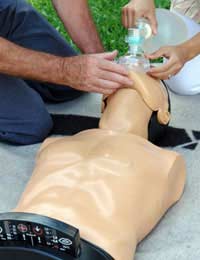First Aid in the Community

What happens if there’s an accident in your community or if someone has a heart attack? There might not be a hospital close, or even a nearby doctor’s surgery, and the emergency services could take too long to arrive. That’s why it’s vital to have first aid services of some sort in every neighbourhood.
According to St. John’s Ambulance, where a person suffers a cardiac arrest, they lose consciousness, and without CPR in the first three to four minutes, can suffer permanent damage.
Getting First Aid into Your Community
Something that’s become a vital part of medical services are Neighbourhood First Responders. These are lay people, trained by St. John’s Ambulance, who can respond very quickly in their own communities. They’re not meant to cope with disasters, but everyday events like injuries, giving CPR and using defibrillators.These are volunteer positions, working on call and on a rota to respond to emergency calls. However, as the time commitment is just four hours a month, any community needs a good number of first responders to cover the area.
Helping to organise and co-ordinate a group of First Responders helps your community. That’s especially true in more rural areas, which are usually more isolated, but it’s also applicable in cities, towns – anywhere you can think of. The quicker treatment can be given, the more chance of saving a life. First Responders stand as an initial line of defence for the community, and should be honoured as such. After all, they’re the ones giving their time to help others.
First Aid Training
Both St. John’s Ambulance and the British Red Cross organize first aid training for people in communities. St. John’s Ambulance, in particular, has a strong tradition of community involvement, and trains kids from the age of five upwards in first aid; in fact, they have the third largest youth organization in the country. Talk to them, see if it’s possible for them to open a branch in your community. They do also have community projects in some areas.The Red Cross will train volunteers. Remember, the more people you have in the community trained in basic first aid and CPR, the more people are able to help in emergency situations and save lives.Work with one of the organizations to put together a First Aid Awareness Day. Publicise it well, work with local businesses to provide refreshments and snacks (and maybe with other local groups, too). Make it a major event. Be sure to include local surgeries and contact the nearest hospital, too, asking them to be part of all this. It’s possible to create a network between all of these to give increased first aid coverage to the community.
Ongoing Safety
Any group is only as strong as the people involved in it, and over time members drift away. If you have a community day or community gala, make sure you involve the First Responders and St. John’s Ambulance, since they’re ideal places to find new, interested people and recruit members. It’s also a good forum to give thanks to these people.Of course, the trick in any community is to keep interest high in first aid, to have community involvement. Frequent CPR classes are useful for that, along with annual First Aid Awareness Days, to keep people from the community learning and aware of problems.


Re: How Communities Have Changed
Changes like bridge, road etc are not stated
Re: The Community Centre
I'd like to know how someone gets to run a community centre as I'd like to run one
Re: Setting Up a Neighbourhood Watch
Hi iam interested in doung a neighbourhood watch in my area please could you email me what to do iv already been intouch with…
Re: Community Centres: What Part Can They Play?
I just want to say thank you for having this information listed it helped me in understanding some things that…
Re: Helping the Elderly in the Community
My name is Elizabeth Marshall and I was wondering if you could help me, I am looking to do food hampers for the elderly…
Re: Setting Up a Neighbourhood Watch
Do you want to bring your scheme for a field trip to birchgrove(trewen road specifically)
Re: The Role of the Coordinator
When your neighborhood watch goes Wrong... invading the privacy of neighbors or stalking by following their neighbors..and bugging…
Re: The Community Centre
Do you currently use any fire stations as community centres either inside of London or in other Shire Fire & Rescue Services?
Re: Helping the Elderly in the Community
I would like to thank you cause of the beautiful work you are doing in assisting the needs . We are also doing the same…
Re: How to Set Up a Community Newspaper
Just wanted to know how to publish a story on the Internet